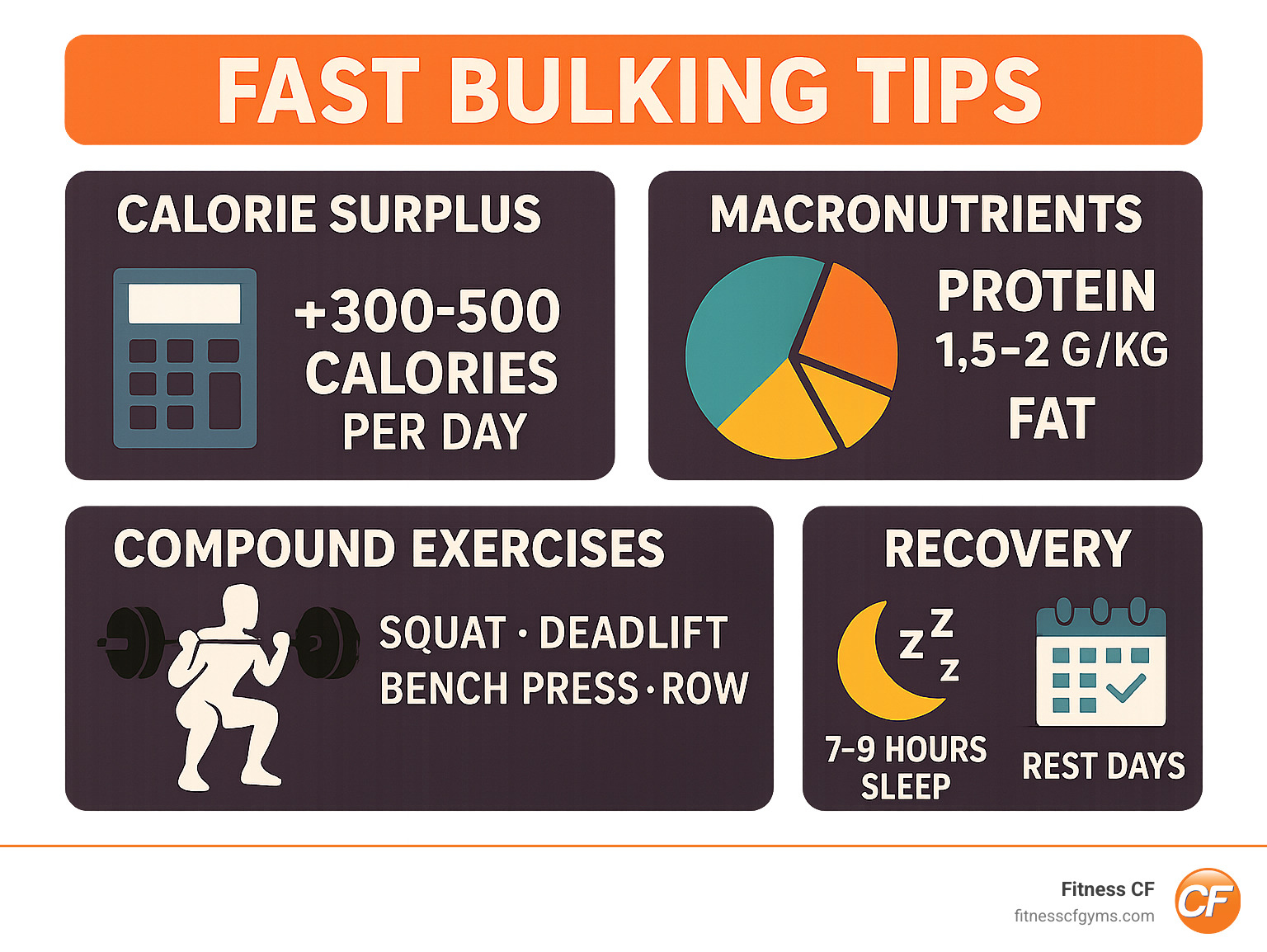Bulk Up Like a Boss: Top Strategies for Rapid Muscle Gain

Why Fast Bulking Tips Matter for Your Fitness Goals
Fast bulking tips can help you build muscle and gain weight more efficiently, but only when done right. The key is creating a controlled calorie surplus while following smart training and recovery strategies.
Quick Fast Bulking Tips:
- Eat 300-500 calories above maintenance – Track your intake daily
- Consume 1.5-2g protein per kg of body weight – Focus on lean sources
- Prioritize compound lifts – Squats, deadlifts, bench press, rows
- Train each muscle group 2-3 times per week – Allow 48 hours recovery
- Get 7-9 hours of sleep nightly – Essential for muscle repair
- Limit cardio to light sessions – Avoid burning too many calories
- Stay consistent for 3-6 months – Realistic muscle gain takes time
Bulking is a phase where you eat more calories than you burn to support muscle growth. When done properly, you can expect to gain 0.25-0.5% of your body weight per week, with most of that being lean muscle rather than fat.
The challenge many people face is knowing how to bulk without gaining excessive fat or spinning their wheels with ineffective strategies. Research shows that a moderate calorie surplus of 300-500 calories per day, combined with strength training and adequate protein, creates the ideal environment for muscle growth.
I’m Pleasant Lewis, and in my 40+ years in the fitness industry, I’ve helped countless members master these fast bulking tips to transform their physiques safely and effectively. My experience has shown that success comes from balancing proper nutrition, smart training, and consistent recovery habits.

Must-know fast bulking tips terms:
The Foundation: Fueling Your Body for Rapid Growth
Your nutrition is everything when it comes to fast bulking tips. You simply cannot build muscle without giving your body the fuel it needs to grow. Think of your body as a construction site: you need more bricks (calories) and workers (protein) to build new structures (muscle). This means focusing on calorie tracking, macronutrients, meal timing, and hydration.
Calculate Your Calorie Surplus
The sweet spot for healthy muscle gain is a calorie surplus of 300-500 calories above your daily needs. First, determine your TDEE (Total Daily Energy Expenditure)—the total calories your body burns. Once you have this number, add your surplus. For example, if your TDEE is 2,500 calories, aim for 2,800-3,000 calories.
Start with a conservative 300 extra calories and monitor your progress. You should gain about 0.25-0.5% of your body weight per week. If the scale doesn’t move after two weeks, increase your intake by another 200-250 calories.
This gradual approach helps minimize fat gain while maximizing lean muscle growth. For more guidance on healthy weight gain approaches, check out these Healthy weight gain strategies.
Master Your Macronutrients for Muscle Gain
While total calories are key, their source determines whether you build muscle or gain fat. Here’s a breakdown of the optimal macro split.
Protein is your muscle-building foundation. Aim for 1.5-2 grams per kilogram of body weight daily (about 0.8-1.0 grams per pound). This provides a constant supply of amino acids for repair and growth.
Carbohydrates fuel your workouts and speed up recovery. Aim for 2-3 grams per pound of body weight from sources like rice, oats, and potatoes to keep your energy steady.
Healthy fats support hormone production, which is crucial for muscle growth. Keep fats around 20% of your total calories, focusing on sources like avocados, nuts, and olive oil.
A good starting point is roughly 40% carbs, 30% protein, and 30% fat. However, hitting your total calorie and protein targets is more important than perfect ratios. For deeper insights, explore these Nutrition Tips for Building Muscle and Losing Fat.
Smart Eating Strategies and Meal Timing
Eating enough to bulk can feel overwhelming, but smart timing and food choices make it manageable.
Eat every 2-4 hours, which usually means three solid meals and 2-3 snacks. This ensures a steady nutrient supply for muscle growth without feeling stuffed.
Post-workout nutrition is a golden opportunity. Consume protein and carbs within 30 minutes of training to kickstart recovery. A protein shake with a banana is a perfect option.
Liquid calories are a game-changer if you struggle with appetite. Smoothies with protein powder, oats, fruit, and nut butter can add 500+ calories easily. This is one of my favorite fast bulking tips for those who get full easily.
Focus on calorie-dense foods like nuts and nut butters. A tablespoon of almond butter has about 100 calories and healthy fats. Add it to meals and snacks for an easy calorie boost.
For specific post-workout meal ideas, check out What to Eat After a Workout.
Clean vs. Dirty Bulking: What’s the Difference?
Choosing the right type of bulk matters for your health and results.
Clean bulking means getting your calories from whole, nutrient-dense foods like lean meats, complex carbs, and healthy fats. This approach builds more muscle with less fat gain, providing more energy and better overall health.
Dirty bulking is the “eat everything” approach, relying on pizza, ice cream, and fast food. While you might gain weight faster, much of it will be fat. This can lead to sluggishness, poor digestion, and long-term health issues.
While an occasional treat is fine, 80-90% of your calories should come from nutritious sources. Your body needs quality nutrients to build quality muscle. Your future self will thank you.
For a complete guide to choosing the right foods for muscle growth, read our Lean Muscle Diet: Your Complete Guide to Foods That Deliver.
Smart Training: The Best Fast Bulking Tips for Your Workouts
While proper nutrition creates the building blocks for muscle growth, your training program provides the crucial signal that tells your body to actually build that muscle. Think of it this way: you can eat all the protein in the world, but without the right training stimulus, your body has no reason to pack on size.
The secret to effective bulking isn’t just about lifting heavy weights randomly. It’s about smart training that maximizes muscle growth while supporting your recovery. This means focusing on compound movements, embracing progressive overload, and finding the right balance with cardio.

Prioritize Compound Lifts for Maximum Mass
When you’re looking for the biggest bang for your buck in the gym, compound exercises are your best friend. These multi-joint movements work several muscle groups at once, creating a powerful stimulus for growth throughout your entire body.
Compound lifts are superior to isolation exercises because they allow you to lift heavier weights and recruit more muscle fibers, creating a greater hormonal response for growth. The big five compound exercises should form the foundation of your routine: Squats, Deadlifts, Bench press, Overhead press, and Rows. These movements allow you to progressively overload with heavier weights over time, which is essential for continued muscle growth.
While isolation exercises have their place, they should complement, not replace, your compound movements during a bulk. For detailed guidance on structuring these exercises into an effective routine, check out How to Structure Lean Muscle Workouts.
Accept Progressive Overload: The Key to Growth
Here’s one of the most important fast bulking tips you’ll ever hear: if you want to get bigger, you absolutely must get stronger. Your muscles adapt quickly, so if you lift the same weights for the same reps week after week, they have no reason to grow.
Progressive overload is the principle that drives all muscle growth. It means consistently challenging your muscles to do more work than they’re accustomed to. You can apply this by increasing the weight, adding more repetitions with the same weight, or increasing the number of sets to add more total volume.
The key is to keep detailed records of your workouts. Write down the weights, sets, and reps for each exercise. This allows you to see your progress clearly and ensures you’re always pushing forward. The goal is to provide a consistent stimulus that encourages adaptation and growth.
For the scientific evidence supporting progressive overload in muscle building, refer to this Scientific research on hypertrophy training.
The Role of Cardio: How to Balance It During a Bulk
Finding the right cardio balance is crucial for bulking. While excessive cardio can hinder your efforts by burning too many calories and impeding recovery, completely avoiding it isn’t ideal. Good cardiovascular health supports your weight training by improving nutrient delivery to your muscles.
Light cardio is the sweet spot during a bulk. A 20-30 minute walk or easy bike ride can boost cardiovascular health without impacting your calorie surplus. These activities can even aid recovery by increasing blood flow.
High-intensity interval training (HIIT) can be beneficial in small doses, like 10-15 minutes once or twice a week. This offers cardiovascular benefits with minimal time and calorie expenditure.
Also, consider non-exercise activity thermogenesis (NEAT)—calories burned from daily movements like walking. Staying active supports your overall health without competing with muscle-building goals.
The bottom line is to keep cardio light and brief. Your primary focus should remain on resistance training and nutrition. For more detailed guidance on this balance, explore Muscle Building and Cardio: How to Create a Balance.

Beyond the Workout: Recovery, Sleep, and Consistency
We’ve covered the fuel and the stimulus. Now, let’s talk about the magic: how your body actually builds muscle. This happens outside the gym, during periods of rest and recovery. Neglecting these aspects is one of the most common mistakes people make when seeking fast bulking tips.
The Power of Rest and Sleep for Muscle Repair
Here’s something that might surprise you: your muscles don’t actually grow during your workout. They grow between workouts, when you’re resting and sleeping. Think of your training as sending a message to your body saying “Hey, we need to get stronger!” But the actual construction work happens when you’re off duty.
When you lift weights, you create tiny micro-tears in your muscle fibers. This sounds scary, but it’s perfectly normal and necessary. During rest periods, your body gets to work repairing these tears, making the fibers stronger and larger than before. This process is called muscle protein synthesis, and it’s the foundation of all muscle growth.
Rest days aren’t lazy days – they’re essential growth days. We recommend giving each muscle group 24-72 hours of rest before training it again. This doesn’t mean sitting on the couch all day, but rather avoiding intense training of the same muscles.
Sleep is where the real magic happens. During deep sleep, your body releases growth hormone, which is crucial for muscle repair and development. Without adequate sleep, you’re essentially sabotaging your own progress. We strongly recommend aiming for 7-9 hours of quality sleep each night to support optimal muscle growth and recovery.
Poor sleep doesn’t just slow your progress – it can actually work against you by increasing cortisol levels, a stress hormone that can break down muscle tissue. Plus, when you’re tired, your workouts suffer, and you’re more likely to make poor food choices.
Aiding Your Bulk: Are Supplements Necessary?
Walk into any supplement store, and you’ll be bombarded with promises of rapid muscle gains and miraculous changes. But here’s the truth: supplements are exactly what their name suggests – they supplement a solid foundation, they don’t replace it.
Our philosophy is always food first. You should aim to get the vast majority of your calories and nutrients from whole, unprocessed foods. Real food provides not just macronutrients, but also vitamins, minerals, and other compounds that work together in ways we’re still finding.
That said, a few supplements can genuinely help support your bulking goals. Protein powder isn’t magic, but it’s incredibly convenient for hitting your daily protein targets, especially after workouts or when you’re on the go. It’s essentially just food in powder form – no different from eating chicken breast, just more convenient.
Creatine is one of the most well-researched supplements available. Taking 3-5 grams daily can improve your workout performance by helping your muscles produce energy more efficiently. This means you can lift heavier weights or squeeze out an extra rep, leading to better progressive overload and more muscle growth over time.
Some people consider mass gainers – high-calorie protein powders loaded with carbs and fats. While they can help hardgainers who struggle to eat enough, they’re often expensive and sugary. A homemade shake with oats, milk, nut butter, and protein powder is usually more nutritious and budget-friendly.
No supplement is a magic bullet. They can’t fix a poor diet or inconsistent training. Always consult with a healthcare professional before adding new supplements to your routine. For safe supplement practices, check out Operation Supplement Safety for safe supplement use.
One of the most crucial fast bulking tips: Be Patient and Consistent
If I could give you just one piece of advice about fast bulking tips, it would be this: building muscle is a marathon, not a sprint. I know “fast” is in the name, but in muscle growth, “fast” is relative.
Let’s set realistic expectations. For most people beyond their beginner phase, healthy muscle gain happens at a rate of about 0.25-0.5% of your body weight per week. This translates to roughly 1-2% per month. So if you weigh 150 pounds, you might gain about 1.5-3 pounds per month, with most of that being lean muscle rather than fat.
A typical bulking phase lasts 3-6 months, sometimes longer depending on your goals and starting point. The key is continuing as long as you’re making lean gains without accumulating excessive body fat. Once you’ve reached your desired muscle mass or feel you’ve gained too much fat, you can transition into a cutting phase to reveal your hard-earned muscle.
Consistency beats perfection every single time. It’s better to follow your plan 80% of the time for six months than to follow it perfectly for three weeks and then give up. Plan your meals ahead of time, stick to your workout schedule, and track your progress diligently.
Progress isn’t always linear – some weeks you’ll feel unstoppable, others you might feel like you’re spinning your wheels. That’s completely normal. Trust the process, celebrate small victories like hitting a new personal best or sticking to your meal plan for a full week, and remember that remarkable results come from consistent effort over time.
The biggest mistake I see people make is giving up too early or constantly changing their approach. Pick a solid plan, commit to it for at least 12 weeks, and watch the magic happen. For more insights on avoiding common pitfalls, read about 11 Common Muscle Building Mistakes and How to Avoid Them.
Frequently Asked Questions about Fast Bulking
How can a skinny person with a fast metabolism bulk up effectively?
If you’re naturally thin with a fast metabolism, you’re what we call a “hardgainer” – and trust me, I’ve worked with countless members who felt like they could eat everything in sight without gaining an ounce. The good news? You absolutely can build muscle, but you’ll need to be more strategic with your approach.
The biggest game-changer is creating a more significant calorie surplus than the typical 300-500 calories we usually recommend. You might need to push that to 500-1000 calories above your maintenance level just to see the scale move. This isn’t about eating junk food – it’s about smart, calorie-dense choices.
Increasing your meal frequency becomes crucial here. Instead of forcing yourself to eat massive portions three times a day, aim for 5-6 smaller meals throughout the day. This makes hitting your calorie targets much more manageable and less overwhelming.
One of my favorite fast bulking tips for hardgainers is embracing liquid calories. Smoothies are your best friend – blend together protein powder, oats, banana, peanut butter, and whole milk for an easy 800+ calorie shake that doesn’t leave you feeling stuffed. You can sip on these between meals or use them as meal replacements when you’re short on time.
Sleep becomes even more critical for fast metabolizers. Your body is already working overtime, so those 7-9 hours of quality rest are essential for recovery and hormone optimization. Finally, minimize excessive cardio during your bulk. Every calorie you burn on the treadmill is a calorie that could have gone toward muscle growth.
What is a realistic rate of muscle gain per week or month?
Let’s set realistic expectations here because social media has given everyone wildly unrealistic ideas about muscle building. Despite what those change photos might suggest, building muscle is a slow, steady process that requires patience.
For most people, especially those past their beginner phase, you can realistically expect to gain 0.25-0.5% of your body weight per week. This translates to roughly 1-2% of your body mass per month. So if you weigh 150 pounds, you’re looking at gaining about 0.4 to 0.75 pounds per week, or roughly 1.5 to 3 pounds per month.
I know this might seem slow, especially when you’re eager to see results, but this steady rate ensures that most of your weight gain is actual muscle tissue, not just fat. We’re aiming for quality gains that you’ll be proud to show off, not just numbers on a scale.
Beginners often experience faster initial gains due to “newbie gains,” but even then, patience is key. The tortoise really does win this race, and consistent progress over months and years creates truly impressive changes.
How long should a typical bulking phase last before cutting?
The duration of your bulking phase isn’t set in stone – it depends on your starting point, goals, and how your body responds to the increased calories. Most successful bulks last 3 to 6 months, though some people, particularly those starting very lean or hardgainers, might bulk for longer periods.
The key is monitoring your progress rather than watching the calendar. As long as you’re gaining weight at that healthy rate of 0.25-0.5% of your body weight per week and you’re not accumulating excessive body fat, you can continue bulking. I typically tell members to assess their progress monthly – are you still making lean gains? Do you feel comfortable with your current body fat level?
The sweet spot is continuing your bulk as long as you’re making quality muscle gains without excessive fat accumulation. Once you notice that most of your weight gain is coming from fat rather than muscle, or you’ve reached your desired muscle mass, it’s time to consider transitioning to a cutting phase.
Bulking and cutting are cyclical processes. You’re not committing to one phase forever – you’re strategically using each phase to work toward your ultimate physique goals. Some of my most successful members have done multiple bulk and cut cycles over several years to build their ideal physique.
Conclusion: Your Path to a Stronger Physique
Your journey to building a stronger, more muscular physique doesn’t have to be complicated. The fast bulking tips we’ve covered throughout this guide form a simple but powerful framework: eat in a strategic calorie surplus, master your macronutrients, focus on compound lifts with progressive overload, and prioritize rest and recovery.
Building muscle is truly a holistic process. Your nutrition provides the raw materials your body needs to grow. Your training gives your muscles the stimulus they need to adapt and get stronger. Your recovery time is when the actual magic happens – when your body repairs and rebuilds itself bigger than before.
The beauty of these principles is that they work together. You can’t out-train a poor diet, and you can’t out-eat lazy training. When you combine smart eating with consistent workouts and adequate sleep, you create the perfect environment for muscle growth.
Building muscle takes patience, but the rewards extend far beyond just looking good. Strength training improves your bone density, boosts your metabolism, improves your mood, and gives you confidence that carries into every area of your life. The discipline you develop in the gym and kitchen becomes a foundation for success everywhere else.
At Fitness CF, we believe in empowering you with the knowledge and tools for a healthy lifestyle. We understand that every person’s journey is unique, and we’re here to support you as you work toward your full potential. Whether you’re just starting out or looking to break through a plateau, these fast bulking tips will serve you well.
Your stronger physique is waiting for you. The only question is: are you ready to put in the consistent work to get there?







